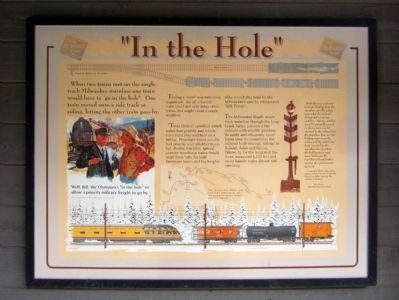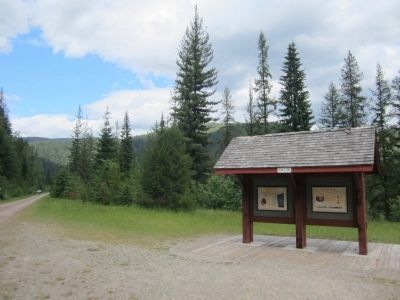Near Avery in Shoshone County, Idaho — The American West (Mountains)
"In the Hole"
When two trains met on the single track Milwaukee mainline one train would have to “go in the hole”. One train moved onto a side track or siding, letting the other train pass by.
Timing a “meet” was extremely important. An off schedule train could not only delay other trains, but might cause a major accident.
“Train Orders” specified which trains had priority and which ones must stop and hold on a siding. Passenger trains usually had priority over all other trains but, during war-time, special, priority munitions trains would send them ‘into the hole’. Passenger trains and big freights alike would hold for the Milwaukee’s speedy, refrigerated “Silk Trains”>
The Milwaukee Road’s single track mainline through the Loop Creek Valley presented the railroad with a traffic problem. To safely and efficiently move trains over the mountains the railroad built strategic sidings at Roland, Adair and Falcon. Falcon, by far the longest of the three, measured 6,552 feet and could handle trains almost 100 cars long.
(sidebar)
Both the east and west turnouts leading from the mainline onto the siding were what the railroad designated as spring switches. Spring switches must be manually moved so that a train can be shunted to the siding from the mainline, but once the holding train is on the siding and the switch has been returned to the mainline-clear position, the holding train may move back onto the mainline without further moving the switch-points by hand.
…I acquired all this trivia about spring switches because I actually helped my father (operate the switches sat Falcon)..
Stan Johnson
The Milwaukee Road Revisited
Topics. This historical marker is listed in this topic list: Railroads & Streetcars.
Location. 47° 21.023′ N, 115° 40.676′ W. Marker is near Avery, Idaho, in Shoshone County. Marker can be reached from Moon Pass Road (Federal Road 456) 0.4 miles south of Loop Creek Road (Federal Road 326). Located along the Route of the Hiawatha Trail. Touch for map. Marker is in this post office area: Avery ID 83802, United States of America. Touch for directions.
Other nearby markers. At least 8 other markers are within 2 miles of this marker, measured as the crow flies. World Class Workers (here, next to this marker); Secluded Falcon (a few steps from this marker); The Toughest Town (a few steps from this marker); Smooth as Silk (approx. 0.7 miles away); Man’s Mark on the Land (approx. 0.9 miles away); A Changing Landscape (approx. 0.9 miles away); Water Does the Work! (approx. 0.9 miles away); Railroad at WAR! (approx. 1.4 miles away). Touch for a list and map of all markers in Avery.
More about this marker. On the left is an illustration with the caption, "Well, Bill, the Olympian's “in the hole” to allow a priority military freight to go by." From a World War II Milwaukee Road advertisement.
On the right is a map with the caption, "The Milwaukee Road had thirteen sidings in the 46 miles between Avery and St. Regis."
Also see . . . Route of the Hiawatha Rail Trail. (Submitted on August 5, 2011, by Bernard Fisher of Richmond, Virginia.)
Credits. This page was last revised on June 16, 2016. It was originally submitted on August 5, 2011, by Bernard Fisher of Richmond, Virginia. This page has been viewed 848 times since then and 8 times this year. Photos: 1, 2. submitted on August 5, 2011, by Bernard Fisher of Richmond, Virginia.

